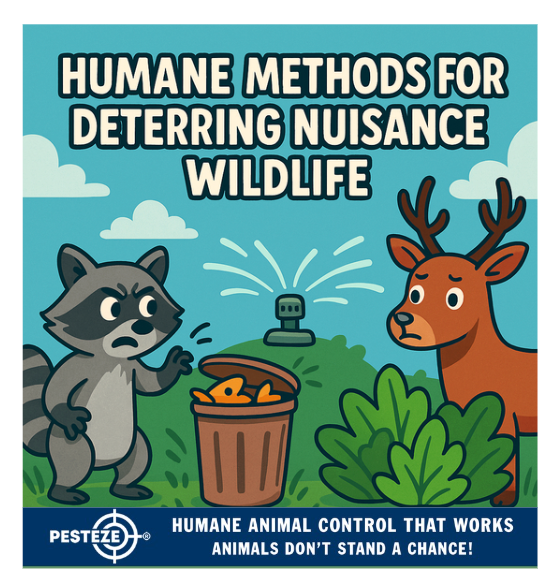HUMANE METHODS FOR DETERRING NUISANCE WILDLIFE

HUMANE METHODS FOR DETERRING NUISANCE WILDLIFE
SUMMARY
Wildlife plays an important role in nature, but when animals become a nuisance around homes, humane solutions are best. This guide covers safe, ethical ways to deter wildlife without causing harm.
FEATURES
-
Secure attractants: Store trash, pet food, and compost properly.
-
Habitat modification: Trim vegetation and seal hiding spots.
-
Motion-activated deterrents: Lights, sprinklers, or sounds.
-
Repellent sprays: Safe, non-toxic deterrents for specific animals.
-
Exclusion methods: Seal entry points into attics, sheds, or crawlspaces.
-
Professional guidance: Contact wildlife experts for persistent issues.
GUIDE DESCRIPTION
Coexisting with wildlife is part of living near nature, but animals like raccoons, squirrels, deer, or skunks can sometimes cause problems. Using humane methods to deter nuisance wildlife ensures you protect your property while respecting the well-being of animals.
The first step is to secure attractants. Many animals are drawn to easy food sources like garbage cans, pet food, bird feeders, or open compost bins. Storing food in sealed containers, using wildlife-proof trash cans, and cleaning up outdoor feeding areas can dramatically reduce unwanted visits.
Habitat modification is another effective strategy. Overgrown shrubs, woodpiles, and unsealed crawlspaces provide shelter for wildlife. Keeping grass trimmed, sealing gaps under decks, and clearing debris can make your property less appealing.
Adding motion-activated deterrents can provide an immediate solution. Sprinklers, lights, or ultrasonic sound devices startle animals when triggered, encouraging them to avoid the area. These are especially useful for protecting gardens from deer or raccoons.
For more specific deterrence, repellent sprays are available. Non-toxic sprays made with natural ingredients like garlic, peppermint, or predator urine mimic danger and discourage animals from coming close. These work well for skunks, rabbits, and deer.
Exclusion methods are some of the most reliable long-term solutions. Animals often enter attics, chimneys, or sheds looking for shelter. Sealing entry points with mesh, installing chimney caps, and repairing holes prevents wildlife from getting inside.
If nuisance wildlife continues to be a problem, it’s wise to seek professional guidance. Licensed wildlife control specialists can provide humane removal and long-term prevention strategies while ensuring compliance with local animal laws.
By focusing on prevention, safe deterrents, and exclusion, you can maintain a balance that protects both your property and local wildlife. Humane solutions not only solve immediate problems but also promote coexistence with nature.
- Saneeth Thota


Comments 0